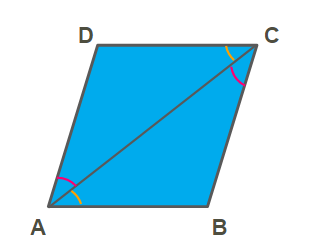PDF chapter test TRY NOW
Theorem I: In a parallelogram, opposite sides are equal.

Given: A parallelogram \(ABCD\) with \(AC\) as its diagonal.
To prove: \(\Delta ABC\cong\Delta ADC\).
Proof: We know that 'Opposite sides of a parallelogram are parallel'. So, \(AB||DC\) and \(AD||BC\).
Since \(AB||DC\) & \(AC\) is the transversal.
\(∠BAC =∠DCA\) (Alternate angle ...1(yellow)).
Since \(AD||BC\) & \(AC\) is the transversal.
\(∠DAC =∠BCA\) (Alternate angle ...2(red)).
In \(△ABC\) & \(△ ADC\).
\(∠BAC =∠DCA\) (From alternate angle ...1).
\(∠DAC =∠BCA\) (From alternate angle ...2).
\(AC=AC\) (common in both).
Thus, by the \(ASA\) criterion, the two triangles are congruent, which means that the corresponding sides must be equal.
Hence, \(AB=CD\) & \(AD=BC\) (corresponding parts of congruent triangles).
Hence, it is proved.
Theorem II: A diagonal of a parallelogram divides it into two congruent triangles.

Given: A parallelogram \(ABCD\) with \(AC\) as its diagonal.
To prove: \(ΔABC ≅ ΔADC\).
Proof: We know that 'Opposite sides of a parallelogram is parallel'. So, \(AB||DC\) and \(AD||BC\).
Since \(AB||DC\) & \(AC\) is the transversal.
\(∠BAC =∠DCA\) (Alternate angle ...1(yellow)).
Since \(AD||DC\) & \(AC\) is the transversal.
\(∠DAC =∠BCA\) (Alternate angle ...2(red)).
In \(△ABC\) & \(△ ADC\).
\(∠BAC =∠DCA\) (From alternate angle ...1).
\(∠DAC =∠BCA\) (From alternate angle ...2).
From the above figure, we can write as follows:
\(∠BAC +∠BCA\) \(=\) \(∠DAC + ∠DCA\)…(1)
Apply angle sum property to the triangle \(ABC\).
\(∠B+∠BAC+∠BCA =180°\)…(2)
Now apply angle sum property to the triangle \(ACD\).
\(∠D+∠DAC+∠DCA=180°\)…(3)
Comparing (2) and (3) with (1) we have:
\(∠B = ∠D\).
From the theorem I, \(AB=CD\) & \(AD=BC\).
Thus, by the \(SAS\) criterion, the two triangles \(ABC\) and \(ADC\) are congruent, which means that the corresponding sides must be equal.
Hence, it is proved.
